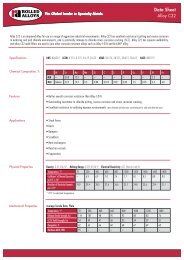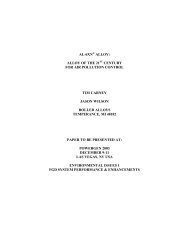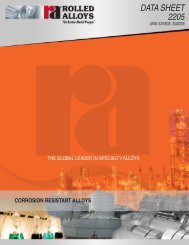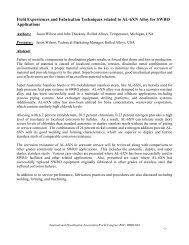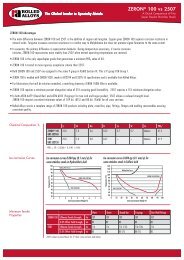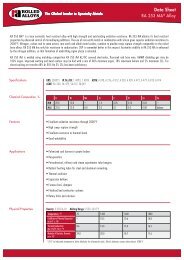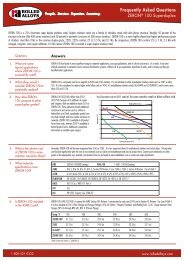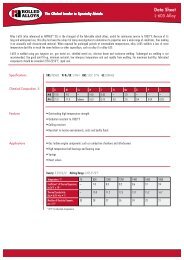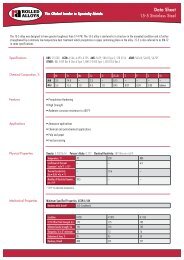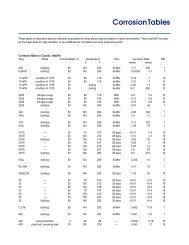Molten Metals [Heat Resistant Alloys (Environments)] - Rolled Alloys
Molten Metals [Heat Resistant Alloys (Environments)] - Rolled Alloys
Molten Metals [Heat Resistant Alloys (Environments)] - Rolled Alloys
You also want an ePaper? Increase the reach of your titles
YUMPU automatically turns print PDFs into web optimized ePapers that Google loves.
Silver—silver braze alloys have long been known to crack or dissolve austenitic alloys.<br />
Cold worked 300 series stainless steels can not be silver brazed without danger of<br />
cracking. One reason is that silver braze, in contrast to copper braze metal, melts well<br />
below the annealing or even stress relieving temperature of the austenitic alloy to be<br />
brazed. In hydrogen atmosphere braze retorts, molten silver braze alloy dripping on the<br />
bottom of an RA330 retort will penetrate this austenitic alloy at the grain boundaries and<br />
cause hydrogen leaks.<br />
Solder (lead-tin)—no molten metal attack reported. Temperatures are low, and the<br />
chloride fluxes used are more of a corrosive problem than is the solder itself. RA333 alloy<br />
has been used in tin can soldering applications, again more to withstand the ammonium<br />
chloride flux than the Pb-Sn alloy.<br />
Tin—both RA446 3/16” (4.8mm) plate and RA 253 MA sheet have been used for side<br />
shields in the tin float process of plate glass manufacture. Tin at 600°C (1112°F) under<br />
hydrogen<br />
atmosphere is reported to have dissolved, then re-deposited, 304 stainless steel, and to<br />
have pock-marked carbon steel in the same bath, in the process of decontaminating soil.<br />
Zinc—Zinc and zinc alloys are used for both electroplating and hot-dip galvanizing of steel.<br />
Zinc, which melts at 787°F (419C°), may liquid metal embrittle steel at temperatures as low<br />
as about 750°F (400°C) 3 . This may occur with both Zn plated bolts and with galvanized<br />
structural steel. <strong>Molten</strong> zinc can either dissolve or liquid metal embrittle austenitic alloys,<br />
depending upon specific conditions.<br />
Zinc is the most commonly used low melting metal which may affect steel or nickel alloys.<br />
For this reason, data and applications experience are more broadly available for Zn than<br />
for other low melting metals.<br />
<strong>Molten</strong> zinc and zinc-aluminum alloys are used for galvanizing and die casting. Our<br />
observations have been that commercially pure iron, 316L stainless, RA85H, 309, AL-6XN<br />
and alloy C-276 have all been used in molten zinc/zinc alloy with some degree of success.<br />
RA330 is no good at all in molten zinc, and it seems reasonable to assume that the other<br />
nickel-chromium-iron alloys such as 800H or 600 are as bad or worse.<br />
Zinc die casting pots have been heated by gas fired immersion tubes fabricated of RA309.<br />
The tubes are usually plasma sprayed with zirconia to enhance life, but this coating is<br />
subject to damage by mechanical abuse. The 309 weld bead is attacked to a greater<br />
degree than the base metal. One failed 309 tube, which had leaked full of zinc die casting<br />
alloy, was heated rapidly with an oxy-acetylene torch to melt out the zinc. The high<br />
thermal stress coupled with zinc wetting the 309 metal inside cracked the tube. The<br />
fracture surface was typical of liquid metal embrittlement, i.e., it looked like RA330 cracked<br />
by molten calcium or 2024-T4 aluminum cracked by mercury.


![Molten Metals [Heat Resistant Alloys (Environments)] - Rolled Alloys](https://img.yumpu.com/37021840/6/500x640/molten-metals-heat-resistant-alloys-environments-rolled-alloys.jpg)
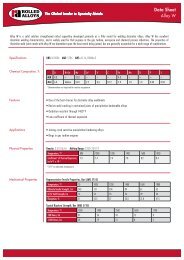
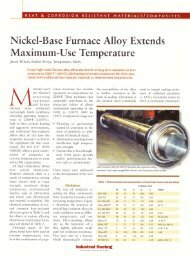
![RA333 Data Sheet [Heat Resistant Alloys] - Rolled Alloys](https://img.yumpu.com/50335849/1/190x245/ra333-data-sheet-heat-resistant-alloys-rolled-alloys.jpg?quality=85)
